Acme Manufacturing Co. Ergonomic Evaluation: OSH4308 Unit 8 Project
VerifiedAdded on 2023/06/09
|6
|1195
|386
Project
AI Summary
This project presents an ergonomic evaluation of the packing line at Acme Manufacturing Company, conducted as part of the OSH4308 course at Columbia Southern University. The evaluation focuses on identifying ergonomic risks faced by employees, specifically addressing the potential for Musculoskeletal Disorders (MSDs). The study utilizes the Recommended Weight Limit (RWL) and Lifting Index (LI) to assess the physical stress associated with manual lifting tasks. Findings indicate that the weight lifted by employees exceeds the recommended limits, and the LI poses a high risk of back pain. The project includes a job analysis worksheet and concludes with recommendations to reduce ergonomic risks and improve workplace safety. These recommendations include implementing stretching exercises, establishing a written ergonomic program, providing breaks, allowing employees to express body feelings, providing training, periodic evaluations, and adjustable chairs. References to relevant research papers are also included.
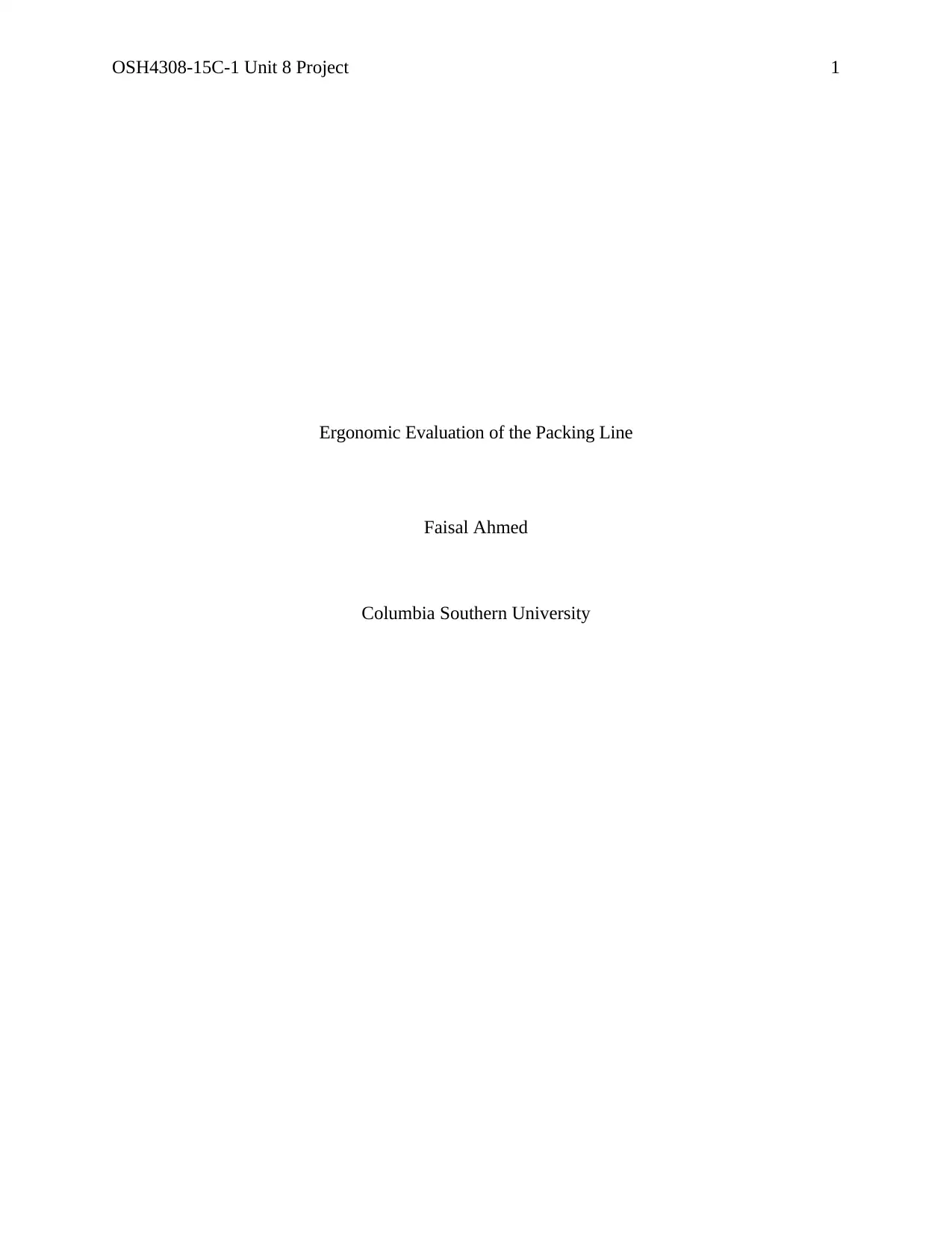
OSH4308-15C-1 Unit 8 Project 1
Ergonomic Evaluation of the Packing Line
Faisal Ahmed
Columbia Southern University
Ergonomic Evaluation of the Packing Line
Faisal Ahmed
Columbia Southern University
Paraphrase This Document
Need a fresh take? Get an instant paraphrase of this document with our AI Paraphraser
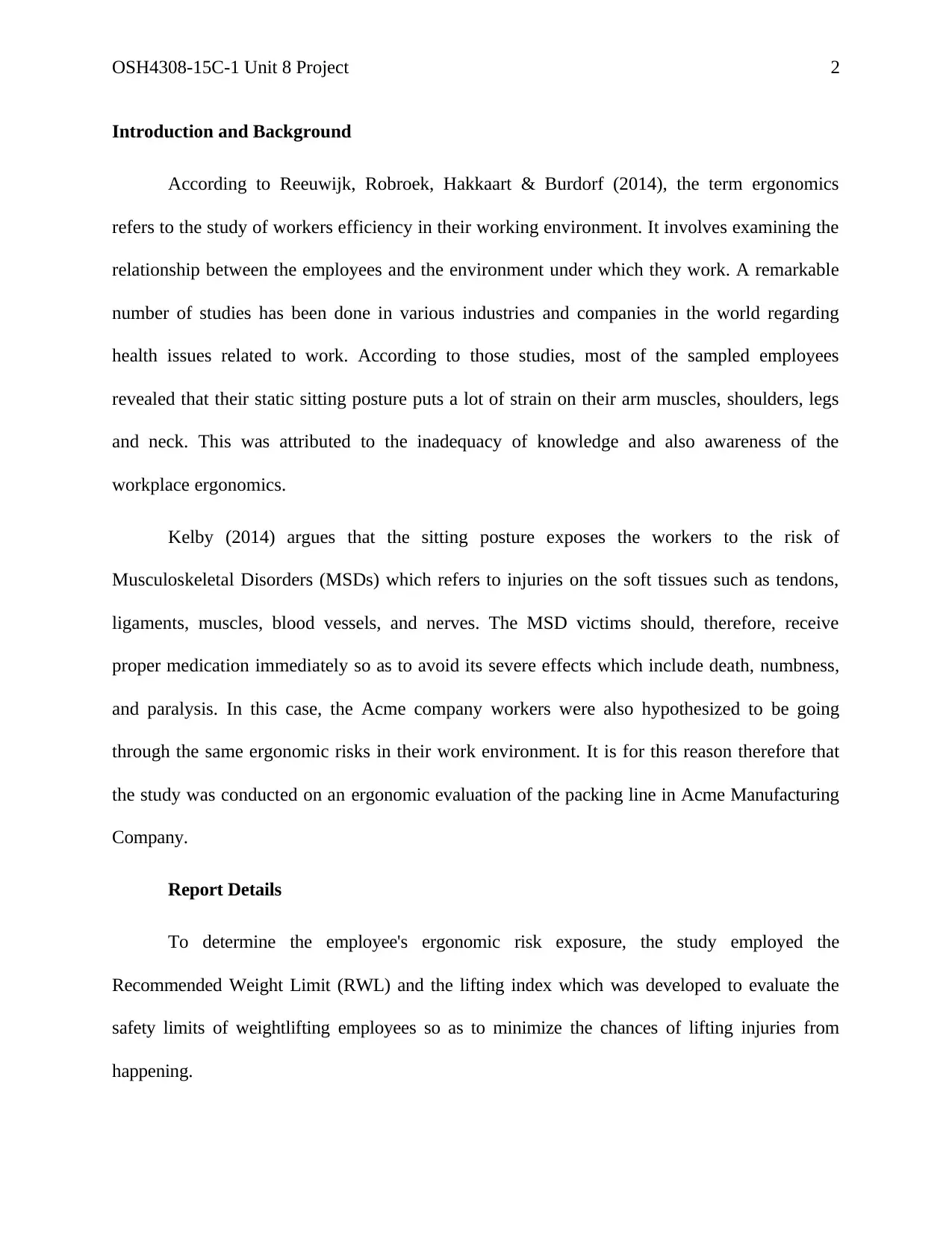
OSH4308-15C-1 Unit 8 Project 2
Introduction and Background
According to Reeuwijk, Robroek, Hakkaart & Burdorf (2014), the term ergonomics
refers to the study of workers efficiency in their working environment. It involves examining the
relationship between the employees and the environment under which they work. A remarkable
number of studies has been done in various industries and companies in the world regarding
health issues related to work. According to those studies, most of the sampled employees
revealed that their static sitting posture puts a lot of strain on their arm muscles, shoulders, legs
and neck. This was attributed to the inadequacy of knowledge and also awareness of the
workplace ergonomics.
Kelby (2014) argues that the sitting posture exposes the workers to the risk of
Musculoskeletal Disorders (MSDs) which refers to injuries on the soft tissues such as tendons,
ligaments, muscles, blood vessels, and nerves. The MSD victims should, therefore, receive
proper medication immediately so as to avoid its severe effects which include death, numbness,
and paralysis. In this case, the Acme company workers were also hypothesized to be going
through the same ergonomic risks in their work environment. It is for this reason therefore that
the study was conducted on an ergonomic evaluation of the packing line in Acme Manufacturing
Company.
Report Details
To determine the employee's ergonomic risk exposure, the study employed the
Recommended Weight Limit (RWL) and the lifting index which was developed to evaluate the
safety limits of weightlifting employees so as to minimize the chances of lifting injuries from
happening.
Introduction and Background
According to Reeuwijk, Robroek, Hakkaart & Burdorf (2014), the term ergonomics
refers to the study of workers efficiency in their working environment. It involves examining the
relationship between the employees and the environment under which they work. A remarkable
number of studies has been done in various industries and companies in the world regarding
health issues related to work. According to those studies, most of the sampled employees
revealed that their static sitting posture puts a lot of strain on their arm muscles, shoulders, legs
and neck. This was attributed to the inadequacy of knowledge and also awareness of the
workplace ergonomics.
Kelby (2014) argues that the sitting posture exposes the workers to the risk of
Musculoskeletal Disorders (MSDs) which refers to injuries on the soft tissues such as tendons,
ligaments, muscles, blood vessels, and nerves. The MSD victims should, therefore, receive
proper medication immediately so as to avoid its severe effects which include death, numbness,
and paralysis. In this case, the Acme company workers were also hypothesized to be going
through the same ergonomic risks in their work environment. It is for this reason therefore that
the study was conducted on an ergonomic evaluation of the packing line in Acme Manufacturing
Company.
Report Details
To determine the employee's ergonomic risk exposure, the study employed the
Recommended Weight Limit (RWL) and the lifting index which was developed to evaluate the
safety limits of weightlifting employees so as to minimize the chances of lifting injuries from
happening.

OSH4308-15C-1 Unit 8 Project 3
The Recommended Weight Limit (RWL)
The Recommended Weight Limit (RWL) is a revised lifting equation of the National
Institute for Occupational Safety and Health (NIOSH). Studies by Dianat et al (2014) have
defined it as the weight limit that can be lifted by any healthy employee for a certain period of time
without increasing the chances of weightlifting problems. The RWL can be used in re-designing
new manual lifting jobs by altering the loads so that they do not exceed the recommended weight.
The study has found that the weight lifted by employees of Acme Manufacturing Company are
past the recommended ‘figures’. This implies that employees in the organization are subjected to
risky packing line, endangering their health.
The Lifting Index
According to Kuijer et al (2016), the Lifting Index (LI) provides an estimated physical
stress due to a manual lifting task. When the lifting task has an index greater than 1.0, it increases
the risk of back pain related to lifting. This implies that the lesser the index, the higher the fraction
of employees that can sustain the level of activity safely. The study found out that the LI in Acme
Manufacturing Company was approximately 2.1. thereby posing workers to the high risk of back
pain related to lifting.
Conclusion
The study has established that there was a disparity between the packing employees and the
working environment which was mainly attributed to poor quality work equipment. There were
also reports on static working areas which contribute to awkward postures hence greater exposure
to ergonomic risks. The working machines are set automatically meaning that they run
The Recommended Weight Limit (RWL)
The Recommended Weight Limit (RWL) is a revised lifting equation of the National
Institute for Occupational Safety and Health (NIOSH). Studies by Dianat et al (2014) have
defined it as the weight limit that can be lifted by any healthy employee for a certain period of time
without increasing the chances of weightlifting problems. The RWL can be used in re-designing
new manual lifting jobs by altering the loads so that they do not exceed the recommended weight.
The study has found that the weight lifted by employees of Acme Manufacturing Company are
past the recommended ‘figures’. This implies that employees in the organization are subjected to
risky packing line, endangering their health.
The Lifting Index
According to Kuijer et al (2016), the Lifting Index (LI) provides an estimated physical
stress due to a manual lifting task. When the lifting task has an index greater than 1.0, it increases
the risk of back pain related to lifting. This implies that the lesser the index, the higher the fraction
of employees that can sustain the level of activity safely. The study found out that the LI in Acme
Manufacturing Company was approximately 2.1. thereby posing workers to the high risk of back
pain related to lifting.
Conclusion
The study has established that there was a disparity between the packing employees and the
working environment which was mainly attributed to poor quality work equipment. There were
also reports on static working areas which contribute to awkward postures hence greater exposure
to ergonomic risks. The working machines are set automatically meaning that they run
⊘ This is a preview!⊘
Do you want full access?
Subscribe today to unlock all pages.

Trusted by 1+ million students worldwide
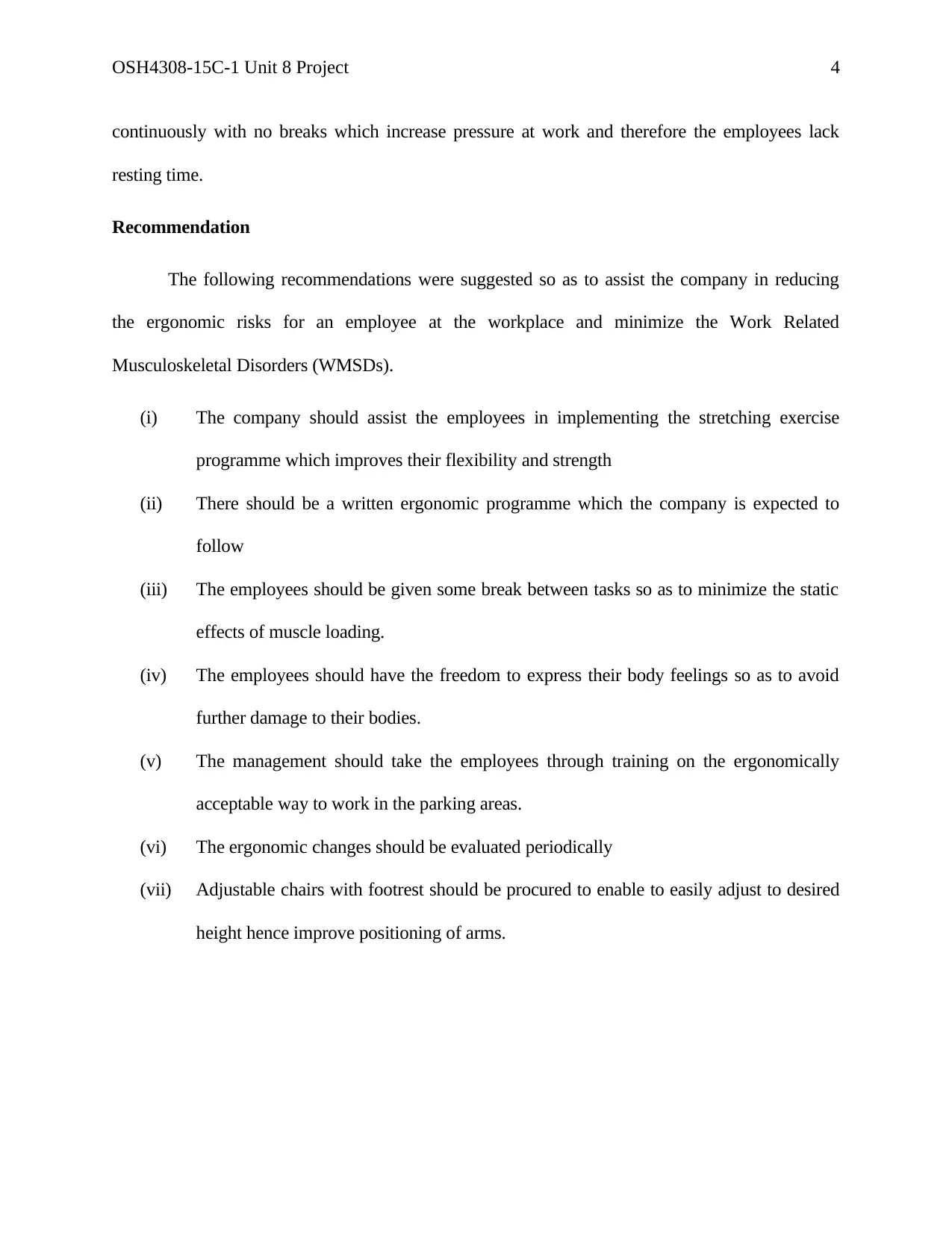
OSH4308-15C-1 Unit 8 Project 4
continuously with no breaks which increase pressure at work and therefore the employees lack
resting time.
Recommendation
The following recommendations were suggested so as to assist the company in reducing
the ergonomic risks for an employee at the workplace and minimize the Work Related
Musculoskeletal Disorders (WMSDs).
(i) The company should assist the employees in implementing the stretching exercise
programme which improves their flexibility and strength
(ii) There should be a written ergonomic programme which the company is expected to
follow
(iii) The employees should be given some break between tasks so as to minimize the static
effects of muscle loading.
(iv) The employees should have the freedom to express their body feelings so as to avoid
further damage to their bodies.
(v) The management should take the employees through training on the ergonomically
acceptable way to work in the parking areas.
(vi) The ergonomic changes should be evaluated periodically
(vii) Adjustable chairs with footrest should be procured to enable to easily adjust to desired
height hence improve positioning of arms.
continuously with no breaks which increase pressure at work and therefore the employees lack
resting time.
Recommendation
The following recommendations were suggested so as to assist the company in reducing
the ergonomic risks for an employee at the workplace and minimize the Work Related
Musculoskeletal Disorders (WMSDs).
(i) The company should assist the employees in implementing the stretching exercise
programme which improves their flexibility and strength
(ii) There should be a written ergonomic programme which the company is expected to
follow
(iii) The employees should be given some break between tasks so as to minimize the static
effects of muscle loading.
(iv) The employees should have the freedom to express their body feelings so as to avoid
further damage to their bodies.
(v) The management should take the employees through training on the ergonomically
acceptable way to work in the parking areas.
(vi) The ergonomic changes should be evaluated periodically
(vii) Adjustable chairs with footrest should be procured to enable to easily adjust to desired
height hence improve positioning of arms.
Paraphrase This Document
Need a fresh take? Get an instant paraphrase of this document with our AI Paraphraser
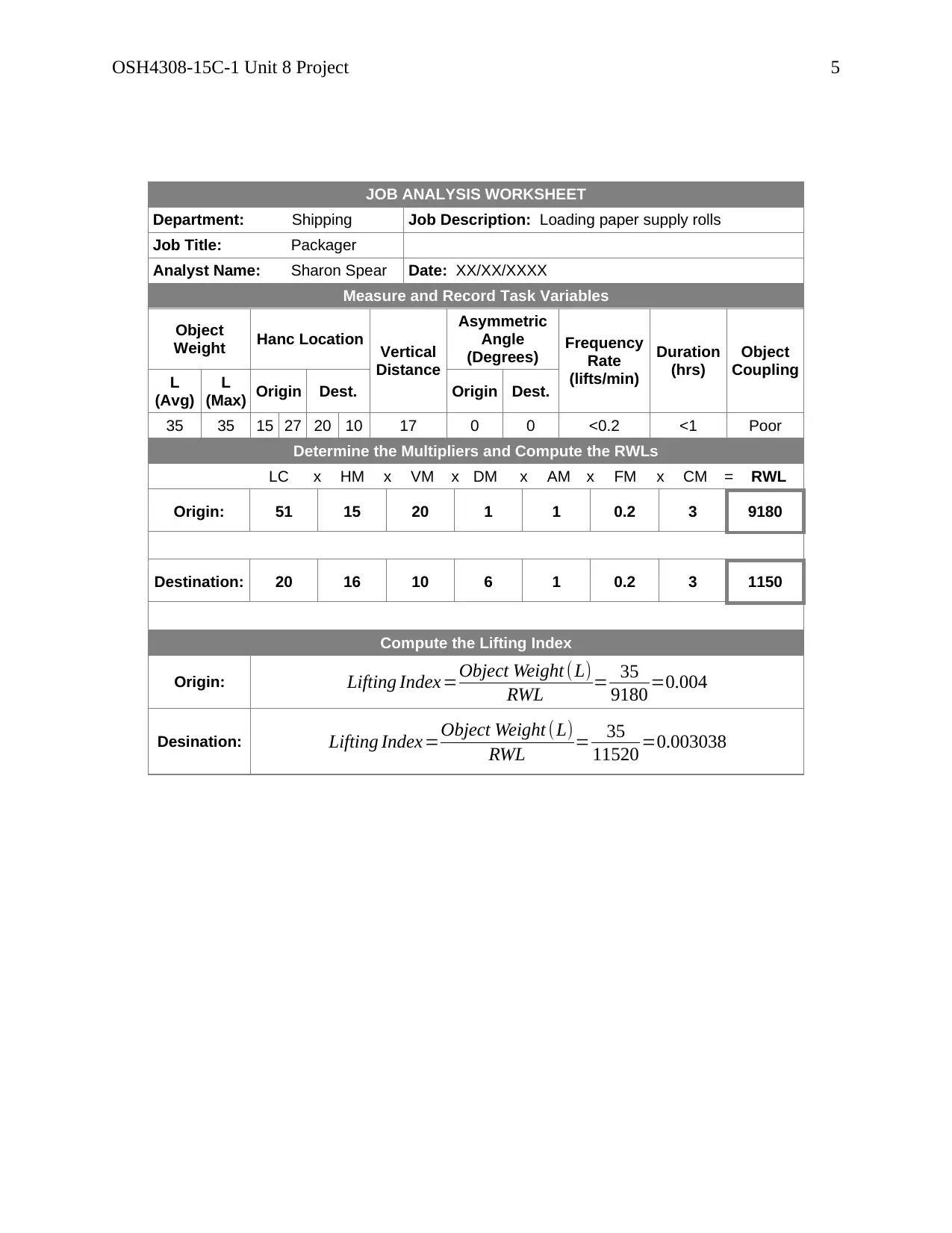
OSH4308-15C-1 Unit 8 Project 5
JOB ANALYSIS WORKSHEET
Department: Shipping Job Description: Loading paper supply rolls
Job Title: Packager
Analyst Name: Sharon Spear Date: XX/XX/XXXX
Measure and Record Task Variables
Object
Weight Hanc Location Vertical
Distance
Asymmetric
Angle
(Degrees) Frequency
Rate
(lifts/min)
Duration
(hrs)
Object
Coupling
L
(Avg)
L
(Max) Origin Dest. Origin Dest.
35 35 15 27 20 10 17 0 0 <0.2 <1 Poor
Determine the Multipliers and Compute the RWLs
LC x HM x VM x DM x AM x FM x CM = RWL
Origin: 51 15 20 1 1 0.2 3 9180
Destination: 20 16 10 6 1 0.2 3 1150
Compute the Lifting Index
Origin: Lifting Index=Object Weight (L)
RWL = 35
9180 =0.004
Desination: Lifting Index=Object Weight (L)
RWL = 35
11520 =0.003038
JOB ANALYSIS WORKSHEET
Department: Shipping Job Description: Loading paper supply rolls
Job Title: Packager
Analyst Name: Sharon Spear Date: XX/XX/XXXX
Measure and Record Task Variables
Object
Weight Hanc Location Vertical
Distance
Asymmetric
Angle
(Degrees) Frequency
Rate
(lifts/min)
Duration
(hrs)
Object
Coupling
L
(Avg)
L
(Max) Origin Dest. Origin Dest.
35 35 15 27 20 10 17 0 0 <0.2 <1 Poor
Determine the Multipliers and Compute the RWLs
LC x HM x VM x DM x AM x FM x CM = RWL
Origin: 51 15 20 1 1 0.2 3 9180
Destination: 20 16 10 6 1 0.2 3 1150
Compute the Lifting Index
Origin: Lifting Index=Object Weight (L)
RWL = 35
9180 =0.004
Desination: Lifting Index=Object Weight (L)
RWL = 35
11520 =0.003038
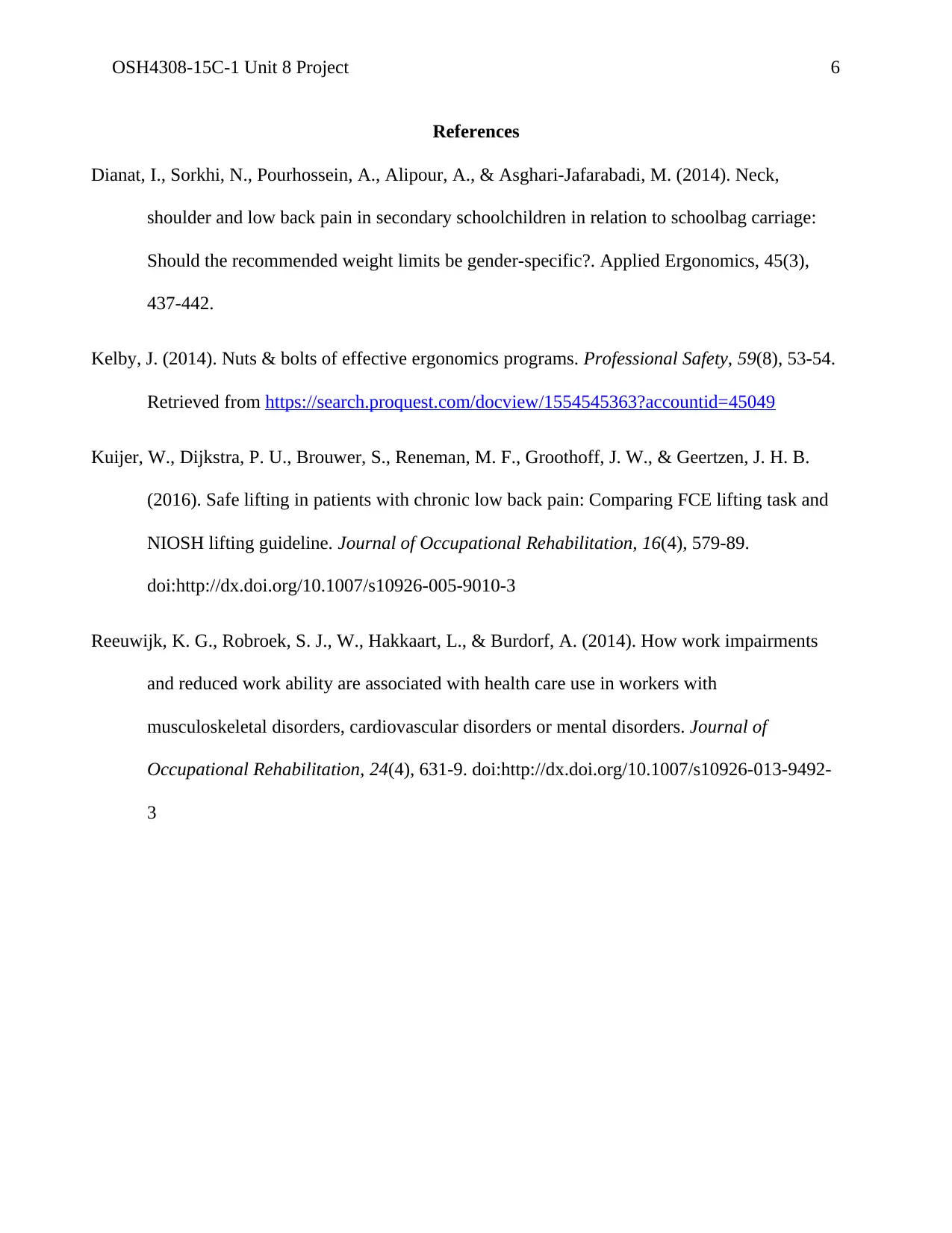
OSH4308-15C-1 Unit 8 Project 6
References
Dianat, I., Sorkhi, N., Pourhossein, A., Alipour, A., & Asghari-Jafarabadi, M. (2014). Neck,
shoulder and low back pain in secondary schoolchildren in relation to schoolbag carriage:
Should the recommended weight limits be gender-specific?. Applied Ergonomics, 45(3),
437-442.
Kelby, J. (2014). Nuts & bolts of effective ergonomics programs. Professional Safety, 59(8), 53-54.
Retrieved from https://search.proquest.com/docview/1554545363?accountid=45049
Kuijer, W., Dijkstra, P. U., Brouwer, S., Reneman, M. F., Groothoff, J. W., & Geertzen, J. H. B.
(2016). Safe lifting in patients with chronic low back pain: Comparing FCE lifting task and
NIOSH lifting guideline. Journal of Occupational Rehabilitation, 16(4), 579-89.
doi:http://dx.doi.org/10.1007/s10926-005-9010-3
Reeuwijk, K. G., Robroek, S. J., W., Hakkaart, L., & Burdorf, A. (2014). How work impairments
and reduced work ability are associated with health care use in workers with
musculoskeletal disorders, cardiovascular disorders or mental disorders. Journal of
Occupational Rehabilitation, 24(4), 631-9. doi:http://dx.doi.org/10.1007/s10926-013-9492-
3
References
Dianat, I., Sorkhi, N., Pourhossein, A., Alipour, A., & Asghari-Jafarabadi, M. (2014). Neck,
shoulder and low back pain in secondary schoolchildren in relation to schoolbag carriage:
Should the recommended weight limits be gender-specific?. Applied Ergonomics, 45(3),
437-442.
Kelby, J. (2014). Nuts & bolts of effective ergonomics programs. Professional Safety, 59(8), 53-54.
Retrieved from https://search.proquest.com/docview/1554545363?accountid=45049
Kuijer, W., Dijkstra, P. U., Brouwer, S., Reneman, M. F., Groothoff, J. W., & Geertzen, J. H. B.
(2016). Safe lifting in patients with chronic low back pain: Comparing FCE lifting task and
NIOSH lifting guideline. Journal of Occupational Rehabilitation, 16(4), 579-89.
doi:http://dx.doi.org/10.1007/s10926-005-9010-3
Reeuwijk, K. G., Robroek, S. J., W., Hakkaart, L., & Burdorf, A. (2014). How work impairments
and reduced work ability are associated with health care use in workers with
musculoskeletal disorders, cardiovascular disorders or mental disorders. Journal of
Occupational Rehabilitation, 24(4), 631-9. doi:http://dx.doi.org/10.1007/s10926-013-9492-
3
⊘ This is a preview!⊘
Do you want full access?
Subscribe today to unlock all pages.

Trusted by 1+ million students worldwide
1 out of 6
Your All-in-One AI-Powered Toolkit for Academic Success.
+13062052269
info@desklib.com
Available 24*7 on WhatsApp / Email
![[object Object]](/_next/static/media/star-bottom.7253800d.svg)
Unlock your academic potential
Copyright © 2020–2025 A2Z Services. All Rights Reserved. Developed and managed by ZUCOL.